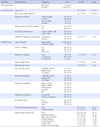1. Bae JH, Choi JY. A study on psychological characteristics of eating disorders: A comparison with restrained, unrestrained (normal) eaters, and overweighters. Korean J Clin Psychol. 1997. 16:209–217.
2. Centers for Disease Control & Korean Pediatric Society. 2007 Korean national growth charts. 2007. Seoul: Author.
3. Cheon SH. A study on eating behavior, depression, anger, anger expression and BAS/BIS in adolescent women. Korean J Women Health Nurs. 2007. 13:310–319.

4. Cho SC, Lee YS. Development of the Korean form of the Kovacs' children's depression inventory. J Korean Neuropsychiatr Assoc. 1990. 29:943–956.
5. Choi JH, Ahn DH, Nam JH, Cho YG, Choi BY. Reliability testing of eating attitude test for Korean adolescents. J Child Adolesc Psychiatry. 1998. 9:91–97.
6. Choi HJ, Yoo YJ. The development of Korean family functioning scale. J Korean Home Manage Assoc. 2003. 21(3):15–28.
7. Dalle Grave R. School-based prevention programs for eating disorders: Achievements and opportunities. Dis Manag Health Outcomes. 2003. 11:579–593.
8. Garner DM, Olmsted MP, Bohr Y, Garfinkel PE. The eating attitudes test: Psychometric features and clinical correlates. Psychol Med. 1982. 12:871–878.

9. Grice DE, Halmi KA, Fichter MM, Strober M, Woodside DB, Treasure JT, et al. Evidence for a susceptibility gene for anorexia nervosa on chromosome 1. Am J Hum Genet. 2002. 70:787–792.

10. Halliwell E, Harvey M. Examination of sociocultural model of disordered eating among male and female adolescents. Br J Health Psychol. 2006. 11:235–248.

11. Hudson JI, Hiripi E, Pope HG Jr, Kessler RC. The prevalence and correlates of eating disorders in the national comorbidity survey replication. Biol Psychiatry. 2007. 61:348–358.

12. Kim JK. Body image and eating disorder of adolescent. J Korean Soc Sch Health. 2002. 15:151–155.
13. Kim JY, Son SJ, Lee JE, Kim JH, Jung IK. The effects of body image satisfaction on obesity stress, weight control attitudes, and eating disorders among female junior high school students. J Korean Home Econ Assoc. 2009. 47:49–59.
14. Kim KH, Yang KM. The relationship between eating disorders and parent-adolescent communication in middle school students in rural areas. J Korean Acad Nurs. 2008. 38:55–63.

15. Kovacs M. The children's depression inventory. Psychopharmacol Bull. 1985. 21:995–998.
16. Lee HJ, Rhie SG, Won HR. Weight, eating habits and dietary self-efficacy of middle school girls with eating disorder. Korean J Community Living Sci. 2008. 19:283–295.
17. Lee JE, Lee LH. Classification of eating disorder patterns of female middle school students and their association with self-body image, weight control behavior, and eating behavior. Korean J Community Living Sci. 2006. 17:89–103.
18. Lee SY, Kim SW, Kang JH. The prevalence of eating disorder risk group among high school students in seoul-relationship of eating disorder symptoms with anxiety and depression tendency. J Korean Soc Study Obes. 2001. 10:376–391.
19. Le Grange D, Lock J, Loeb K, Nicholls D. Academy for eating disorders position paper: The role of the family in eating disorders. Int J Eat Disord. 2010. 43:1–5.

20. Lindberg L, Hjern A. Risk factors for anorexia nervosa: A national cohort study. Int J Eat Disord. 2003. 34:397–408.

21. Beato-Fernández L, Rodríguez-Cano T, Belmonte-Llario A, Martínez-Delgado C. Risk factors for eating disorders in adolescents, A Spanish community-based longitudinal study. Eur Child Adolesc Psychiatry. 2004. 13:287–294.
22. Ministry of Health and Welfare. The epidemiological survey of psychiatric illnesses in Korea 2011. 2011. 12. Seoul: Seoul National University College of Medicine.
23. Parker G, Tupling H, Brown LB. A parental bonding instrument. Br J Med Psychol. 1979. 52:1–10.

24. Pratt BM, Woolfenden SR. Interventions for preventing eating disorders in children and adolescents. Cochrane Database Syst Rev. 2002. (2):CD002891.

25. Shoebridge PJ, Gowers SG. Parental high concern and adolescent-onset anorexia nervosa: A case-control study to investigate direction of causality. Br J Psychiatry. 2000. 176:132–137.

26. Soh NL, Touyz SW, Surgenor LJ. Eating and body image disturbances across cultures: A review. Eur Eat Disord Rev. 2006. 14:54–65.

27. Song JY. The development of the parental bonding instrument-Korean version: Evaluation of the test reliability and validity. J Korean Neuropsychiatr Assoc. 1992. 31:979–991.
28. Stice E. Risk and maintenance factors for eating pathology: A meta-analytic review. Psychol Bull. 2002. 128:825–848.

29. Sung MH. Factors influencing eating disorders of college women. J Korean Soc Sch Health. 2005. 18:71–82.
30. Yoo WS, Kim YN. A study on eating disorders and it's related factors in high school girls. Korean J Community Nutr. 2004. 9:274–284.






 PDF
PDF ePub
ePub Citation
Citation Print
Print




 XML Download
XML Download